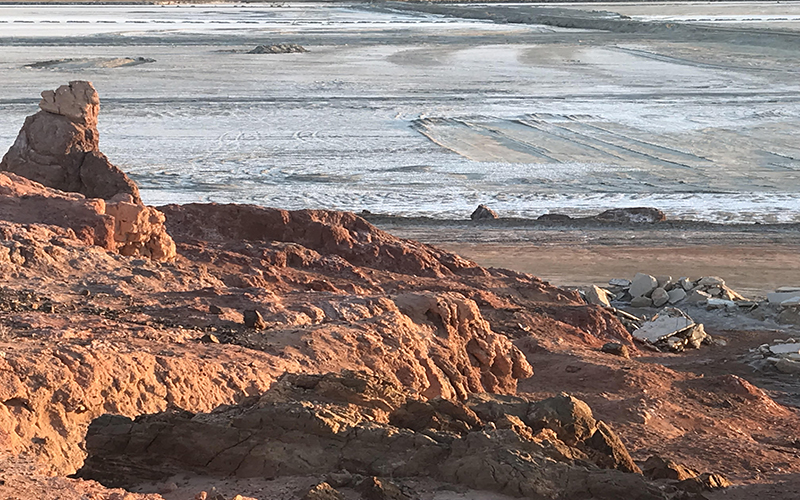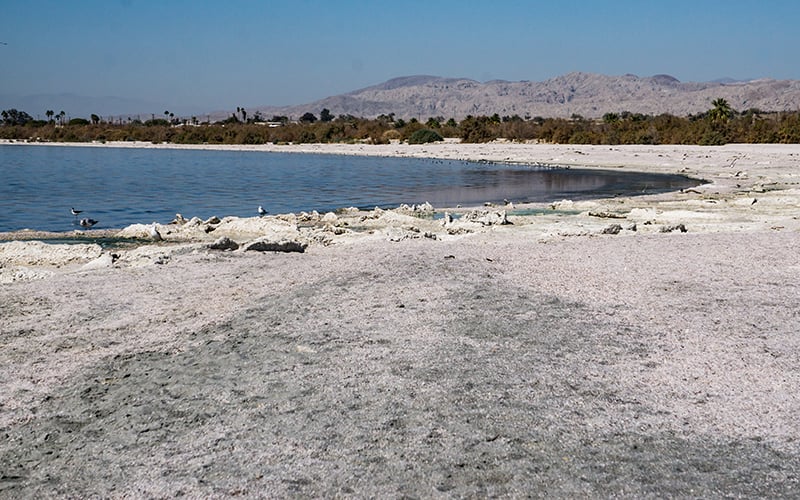California is spending more than $200 million to keep an unfolding ecological crisis from getting worse. The state wants to stabilize habitat along the southern bank of the Salton Sea, the state’s largest lake.
That is good news for nearby residents concerned about their health, but the restoration also could affect everyone who draws water from the Colorado River.
At issue is the wide swaths of exposed lakebed that have been uncovered as the thirsty lake’s water evaporates in the desert air.
The lake bottom is typically a deep layer of fine silt.
Covered by water, it poses no risk. Exposed to the air and whipped up by the region’s strong winds, the dust becomes a major health risk.
The lake has been shrinking for years, in part, because the Imperial Irrigation District sold some of its Colorado River water to San Diego. The irrigation of croplands in the Imperial Valley has sustained the sea’s level over the decades.
But the pace of the retreat jumped dramatically a few years ago and now thousands of acres of lakebed are exposed.
“The notion of this shrinking sea and the emissive dust coming from the seabed is really alarming and concerning to local residents, and we understand that,” said Wade Crowfoot, secretary for the California Natural Resources Agency.
This is the first state project to control dust and create habitat. The ground was broken on the 4,000-acre project a few weeks ago. Crowfoot hopes the work near the mouth of the New River is done by 2023.
“It’s a long time in coming,” Crowfoot said. “There’s a real impatience and an understandable impatience of residents in Imperial and Riverside counties about restoration and stabilization of the sea.”
California agreed to take on the Salton Sea restoration when Colorado River users and the federal government signed the Quantification Settlement Agreement in 2003.
That deal cleared the way for Imperial County water to move to urban areas such as San Diego.
The agreement also cut the flow of water into the thirsty desert lake, exposing thousands of acres of the dusty lakebed.
“Every time we’re peeling back every inch of that playa we’re exposing over 100 years of contaminated sediment,” said community activist Luis Olmedo of the Comite Civico del Valle.
Olmedo has worked for years to draw attention to the valley’s dirty air, even setting up air monitors around the Imperial Valley to track the problem. The pollution affects the entire air basin, from Los Angeles to Mexico.
Farms, trucks, and cross-border pollution from factories all combine to heighten the public health risk, leading to higher asthma rates for the valley’s residents.
“Is it because we’re over 85% Latinos?” Olmedo asked. “People of color, living in poverty that are not worth that investment? And here now we have the Salton Sea adding insult to injury.”
Any project that improves air quality is welcome in the county, Olmedo said.
“And that’s what this delivers,” he said. “But it’s just one little tiny project to this massively drying area.”
Because the lake’s decline is directly linked to the 2003 agreement, calls for California to finally start restoration projects have only grown louder.
“Since the QSA was signed some 24,000 acres of playa have been exposed,” said the Pacific Institute’s Michael Cohen. “Projections are it could be another 40,000 to 60,000 acres not accounting for water use by the projects themselves. Some projections suggest it could be 100,000 acres of lakebed exposed.”
The public health threat adds urgency to the restoration efforts. So does the lake’s unique role in western water politics.
The Imperial Irrigation District is the single largest user of Colorado River water across the seven western states that rely on it. District managers hope to leverage their influence to funnel money into Salton Sea restoration efforts, but the restoration push creates difficult choices, Cohen said.
“Should the people and the birds, the people and the environment suffer to deliver additional water to people on the coast of California and to protect flows to Nevada and Arizona and the Republic of Mexico,” Cohen said.
During the sometimes contentious debates in California over the drought contingency plans enacted in 2019, the Salton Sea was often used as a bargaining chip. Imperial Irrigation District officials see the sea’s problems as something for the whole basin to consider and act to address.
The pressure to act increases as the river’s flow diminishes. The Colorado River basin is already in a nearly two-decades long drought.
“The real driver now is climate change,” Cohen said.
With less water flowing down the river to the Imperial Valley, the tension over who gets to tap the resource will grow.
Reduced flows also put extra pressure on California officials trying to keep the Salton Sea from becoming a public health disaster.
This story is part of ongoing coverage of the Colorado River, produced by KPBS, distributed by KUNC, and supported by a Walton Family Foundation grant.



